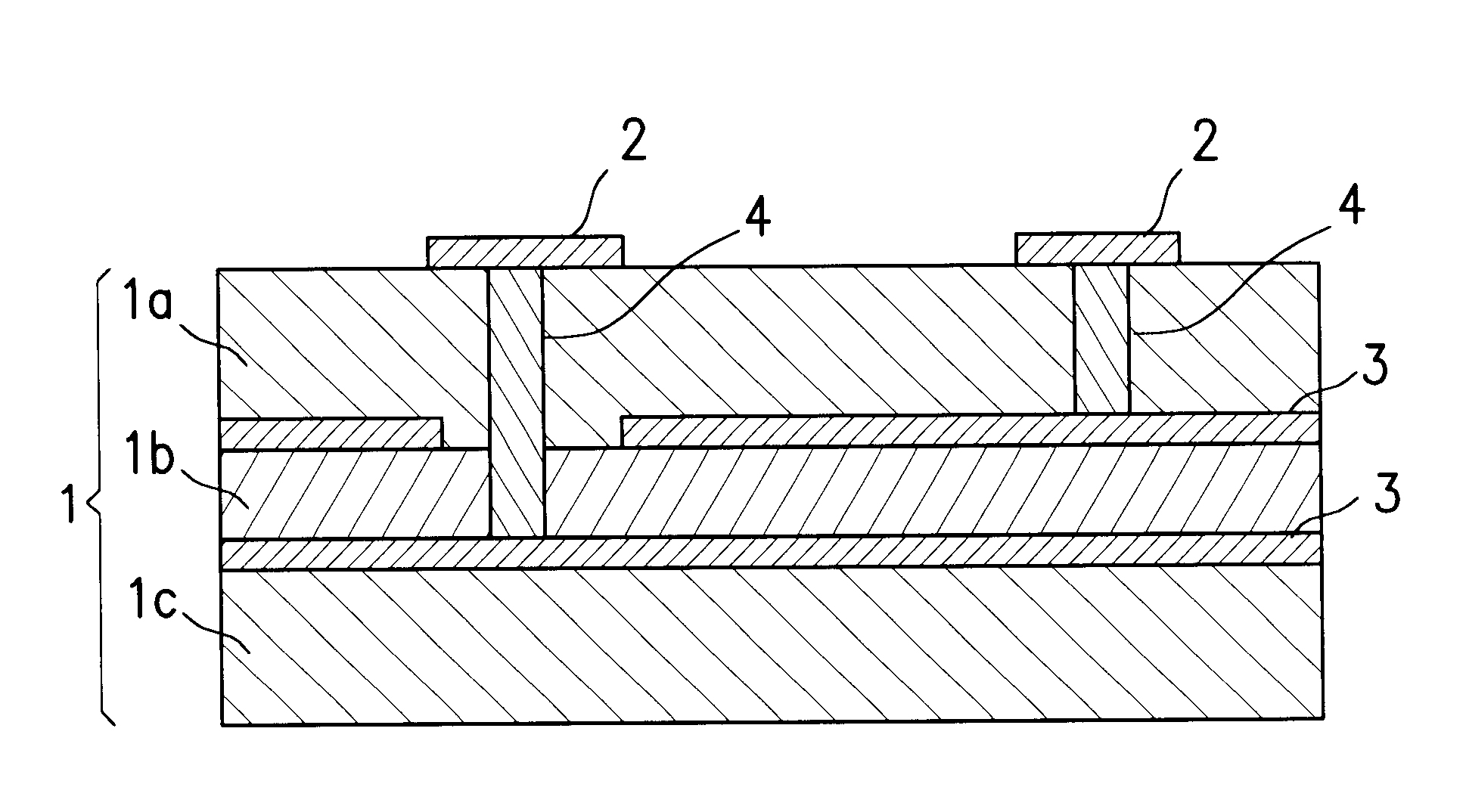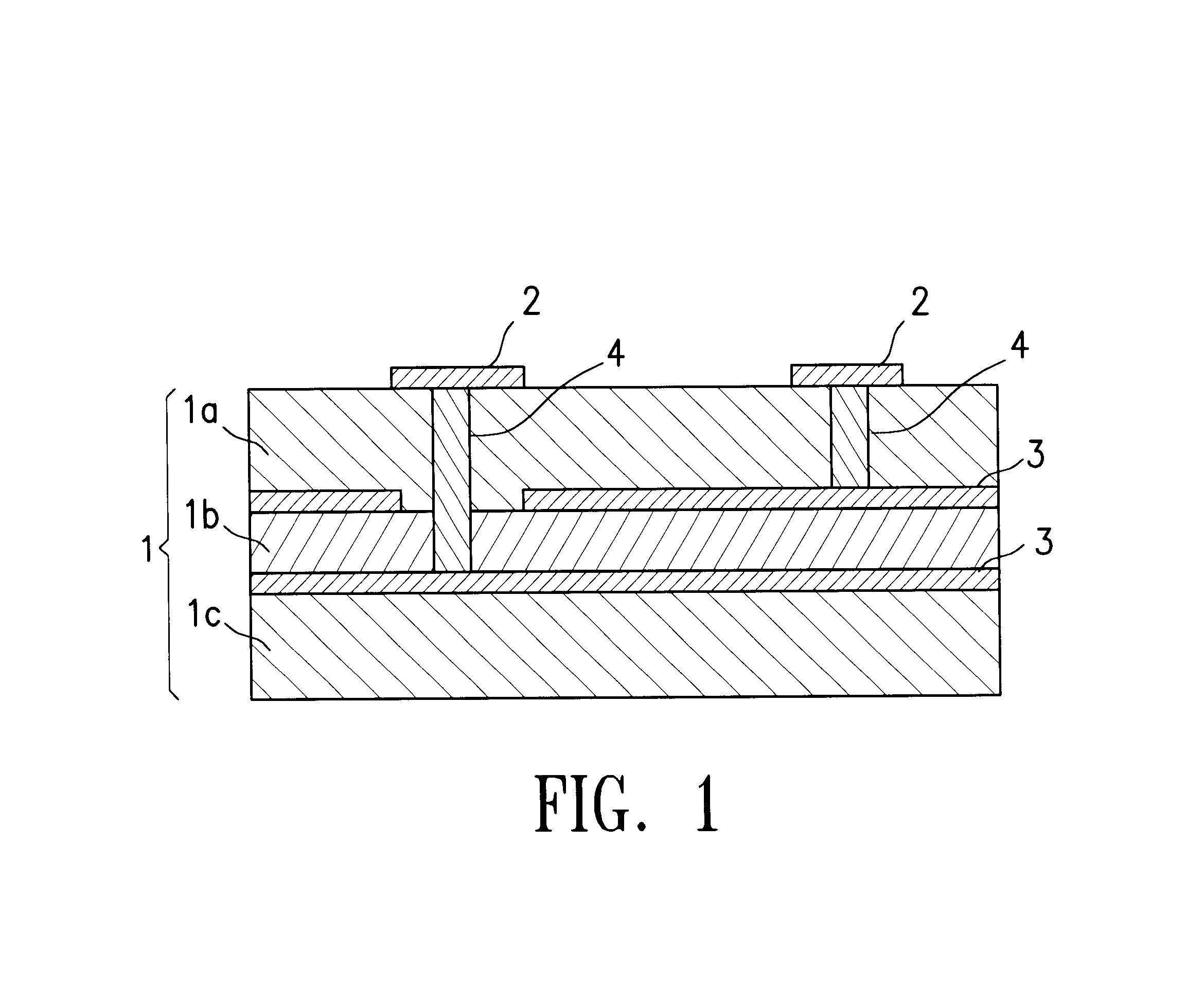Ceramic wiring board
a wiring board and ceramic technology, applied in the direction of ceramic layered products, semiconductor/solid-state device details, transportation and packaging, etc., can solve the problems of difficult to reduce the size and drive up the mounting cost, perovskite dielectric, and cannot be co-fired with glass ceramics, so as to reduce the difference in the coefficient of thermal expansion, and easy laminate
- Summary
- Abstract
- Description
- Claims
- Application Information
AI Technical Summary
Benefits of technology
Problems solved by technology
Method used
Image
Examples
experiment 1-- 1
(Experiment 1--1)
A glass powder (yield point of 700.degree. C., coefficient of thermal expansion of 6.5.times.10.sup.-6 / .degree. C., Pb amount of not larger than 50 ppm) comprising 41% by weight of SiO.sub.2 --37% by weight of BaO--10% by weight of B.sub.2 O.sub.3 --7% by weight of Al.sub.2 O.sub.3 --5% by weight of CaO was prepared, and filer powders shown in Table 1 were prepared. In Table 1, the coefficients of thermal expansion are those at 40 to 400.degree. C.
The fillers of Table 1 were each weighed by 50% by volume and were added to 50% by volume of the glass powder, followed by the addition of a solvent, and were then pulverized and mixed by using a ball mill. Thereafter, an organic binder and a plasticizer were added and mixed to a sufficient degree to prepare slurries from which green sheets having a thickness of 500 .mu.m were prepared by the doctor blade method.
Samples measuring 50 mm.times.50 mm were cut out from the thus obtained green sheets, were pressed, and from wh...
experiment 1-2
(Experiment 1-2)
Sintered products (samples Nos. 10 to 37) were prepared in the same manner as in Experiment 1--1 but changing the composition ratio of lanthanum titanate and glass as shown in Tables 2 to 5, and their properties were evaluated. The results were as shown in Tables 2 to 5.
TABLE 2 No. 10 11 12 13 14 15 16 Glass (vol. %) 30 35 40 45 55 60 70 La.sub.2 O.sub.3 --2TiO.sub.2 70 65 60 55 45 40 30 (vol. %) Porosity (%) 12.4 0.5 0.42 0.43 0.15 0.05 0.03 Coefficient of thermal -- 12.0 11.6 11.2 10.3 10.0 9.5 expansion (x10.sup.-6 / .degree. C.) Dielectric constant -- 22.9 21.3 18.9 15.5 14.1 9.5
TABLE 2 No. 10 11 12 13 14 15 16 Glass (vol. %) 30 35 40 45 55 60 70 La.sub.2 O.sub.3 --2TiO.sub.2 70 65 60 55 45 40 30 (vol. %) Porosity (%) 12.4 0.5 0.42 0.43 0.15 0.05 0.03 Coefficient of thermal -- 12.0 11.6 11.2 10.3 10.0 9.5 expansion (x10.sup.-6 / .degree. C.) Dielectric constant -- 22.9 21.3 18.9 15.5 14.1 9.5
TABLE 4 No. 24 25 26 27 28 29 30 Glass (vol. %) 30 35 40 45 55 60 70 La.su...
experiment 2-1
(Experiment 2-1)
La.sub.2 O.sub.3.2TiO.sub.2 (filler a), CaTiO.sub.3 (filler b) and ZrO.sub.2 (filler c) were prepared as fillers.
The glass powder used in Experiment 1--1 and the above fillers were weighed and mixed together at ratios shown in Table 6, followed by the addition of a solvent, and were then pulverized and mixed by using a ball mill. Thereafter, an organic binder and a plasticizer were added and mixed to a sufficient degree to prepare slurries from which green sheets having a thickness of 500 .mu.m were prepared by the doctor blade method.
Samples measuring 50 mm.times.50 mm were cut out from the thus obtained green sheets, and from which the binder was removed at 750.degree. C. in a nitrogen atmosphere containing water vapor. The samples were then fired at 910.degree. C. in a nitrogen atmosphere to obtain ceramic sintered products (samples Nos. 1 to 43).
The obtained sintered products were measured for their porosities by the Archimedes' method and were measured for their...
PUM
| Property | Measurement | Unit |
|---|---|---|
| Fraction | aaaaa | aaaaa |
| Percent by mass | aaaaa | aaaaa |
| Percent by mass | aaaaa | aaaaa |
Abstract
Description
Claims
Application Information
 Login to View More
Login to View More - R&D
- Intellectual Property
- Life Sciences
- Materials
- Tech Scout
- Unparalleled Data Quality
- Higher Quality Content
- 60% Fewer Hallucinations
Browse by: Latest US Patents, China's latest patents, Technical Efficacy Thesaurus, Application Domain, Technology Topic, Popular Technical Reports.
© 2025 PatSnap. All rights reserved.Legal|Privacy policy|Modern Slavery Act Transparency Statement|Sitemap|About US| Contact US: help@patsnap.com


